Here's an overview:
- Introduction to Ancient Egyptian Cuisine
- The Staple Foods of Ancient Egypt
- The Role of Spices and Herbs in Ancient Egyptian Cooking
- Mealtimes and Eating Habits in Ancient Egypt
- The Significance of Food in Ancient Egyptian Culture and Religion
- Innovative Cooking Techniques and Kitchen Tools of Ancient Egypt
- The Influence of Ancient Egyptian Food on Modern Cuisine
- Notable Ancient Egyptian Recipes and Dishes
- Exploring Ancient Egyptian Beverages
- The Legacy of Ancient Egyptian Food in Today's World
Introduction to Ancient Egyptian Cuisine
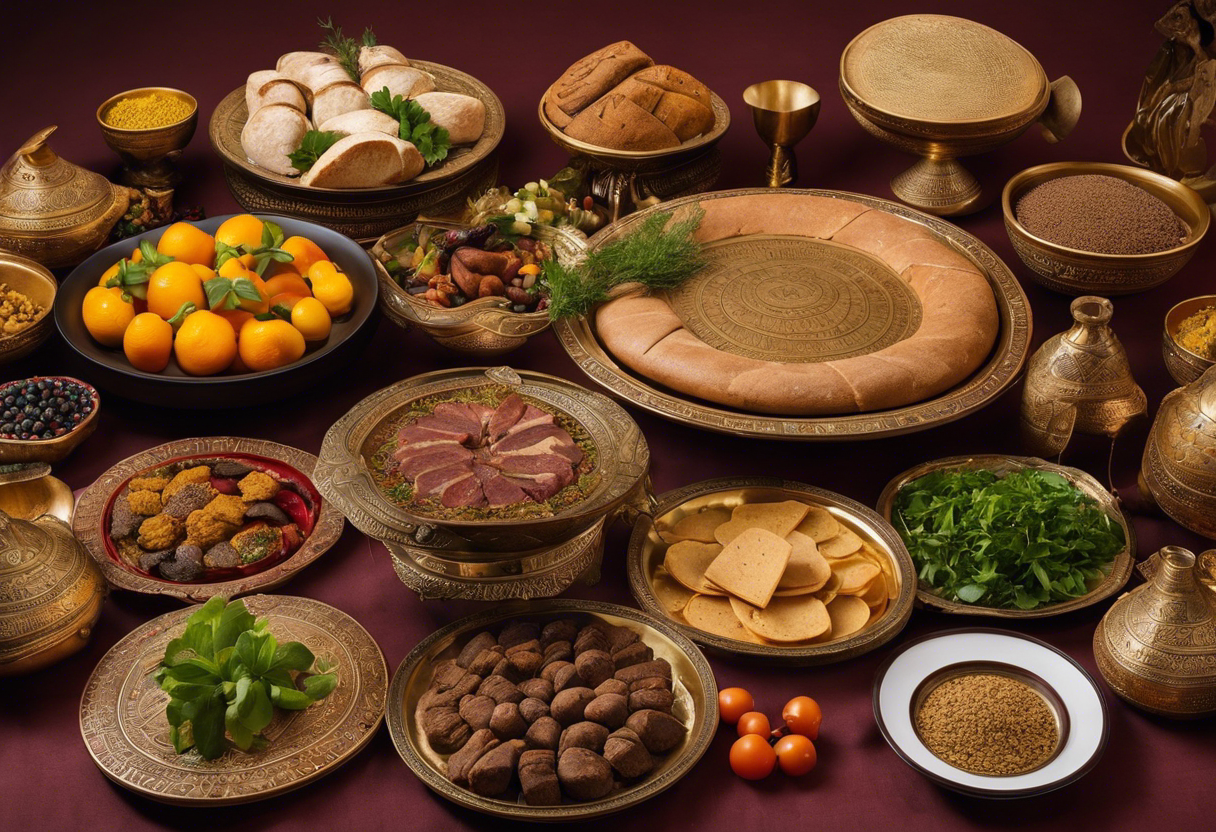
Ancient Egyptian cuisine is a captivating and unique aspect of Egyptian culture that has left an indelible mark on history. The ancient Egyptians valued food not only for sustenance but also as a means to connect with the gods and ensure a prosperous afterlife. The cuisine of this ancient civilization offers a fascinating insight into the rituals, ingredients, and cooking methods that were prevalent during that time.
One of the most distinctive features of ancient Egyptian cuisine is its heavy reliance on staple foods such as bread, vegetables, and grains. Bread, in particular, held great significance in their diet and was consumed at almost every meal. Bread was typically made from barley or emmer wheat and was considered the foundation of a meal. It was often used as a utensil for scooping up other dishes or dipped in various sauces.
Vegetables played a prominent role in ancient Egyptian cuisine as well. Onions, leeks, garlic, and lettuce were commonly eaten and used for flavoring dishes. Fruits such as figs, dates, and grapes were also enjoyed, and honey was used as a sweetener. The availability of fresh produce varied depending on the season, with fish, poultry, and game meat being additional sources of protein.
Ancient Egyptian cuisine was not just about the ingredients but also the preparation methods. The two primary ways of cooking were baking and boiling. Baking, as mentioned earlier, involved the making of bread, but it was also used for meat and fish dishes. Boiling was another popular cooking method, often used for stews and soups. To enhance flavors, the Egyptians used a variety of spices, herbs, and condiments such as cumin, coriander, cinnamon, and mustard.
The ancient Egyptians also had a hierarchy when it came to dining. The wealthy elites enjoyed a more elaborate and varied diet, including dishes like roast duck, quail, and mutton, while the working class primarily relied on bread, vegetables, and legumes for their meals.
The preparation and consumption of food in ancient Egypt were deeply intertwined with religious beliefs and rituals. Food offerings were made to gods and deities as a gesture of gratitude and to seek their favor. The belief was that the gods' consumption of these offerings would ensure fertility, abundance, and blessings for both the living and the deceased.
As we embark on a journey through time to rediscover ancient Egyptian cuisine, we will delve deeper into the recipes, ingredients, and cultural significance that have shaped this rich culinary heritage. Come join us on this exploration of flavors and traditions from one of the world's oldest civilizations.
The Staple Foods of Ancient Egypt

When exploring the cuisine of ancient Egypt, it is essential to understand the staple foods that formed the foundation of their diet. These primary food sources provided sustenance and nourishment to the people of this ancient civilization.
1. Bread
Bread was the most ubiquitous and important staple in ancient Egyptian cuisine. It was consumed by people of all social classes and served as the main source of carbohydrates. Ancient Egyptians used a variety of grains, including barley and emmer wheat, to make bread. The bread was typically baked in clay ovens or on heated stones. Different types of bread included round loaves, flatbreads, and cakes.
2. Beer
Beer held significant cultural and religious importance in ancient Egypt and was considered a staple beverage. Unlike modern beer, ancient Egyptian beer was thick and often consumed through a straw due to the inclusion of sediment. The beverage was brewed using barley, which was soaked, malted, mashed, and fermented. Drinking beer was not only a dietary habit but also a symbol of religious and social gatherings.
3. Meat and Fish
Meat, primarily from domesticated animals such as cattle, sheep, and goats, was consumed by the wealthy and elite classes of ancient Egypt. The lower classes would occasionally enjoy meat on special occasions. Similarly, fish was a vital protein source in the Nile Valley. The Nile River provided ample fish varieties, including Nile perch, catfish, and tilapia. Fish was often dried, salted, or preserved in brine for longevity, allowing it to be eaten even during times of scarcity.
4. Vegetables and Fruits
Ancient Egyptians had access to an abundant variety of vegetables and fruits. Common vegetables included onions, garlic, leeks, lettuce, cucumbers, and radishes. Fruits such as dates, figs, melons, and grapes were also part of their diet. These fresh produce items were not only consumed for their nutritional value but also had therapeutic applications in ancient Egyptian medicine.
5. Legumes and Grains
Legumes, such as lentils and chickpeas, played a significant role in ancient Egyptian cuisine. These protein-rich foods were consumed in various forms, including in stews, soups, and as side dishes. Grains like barley, emmer wheat, and spelt were not only used for making bread but also for porridge and as additives in other dishes. These versatile ingredients were vital in providing sustenance to the ancient Egyptians.
Understanding the staple foods of ancient Egypt helps us appreciate the resilience and resourcefulness of this ancient civilization. The combination of bread, beer, meat, fish, vegetables, fruits, legumes, and grains formed a balanced and diverse diet that sustained the population for centuries. This insight into their culinary traditions allows us to glimpse the richness of ancient Egyptian culture and the importance of food in their daily lives.
The Role of Spices and Herbs in Ancient Egyptian Cooking
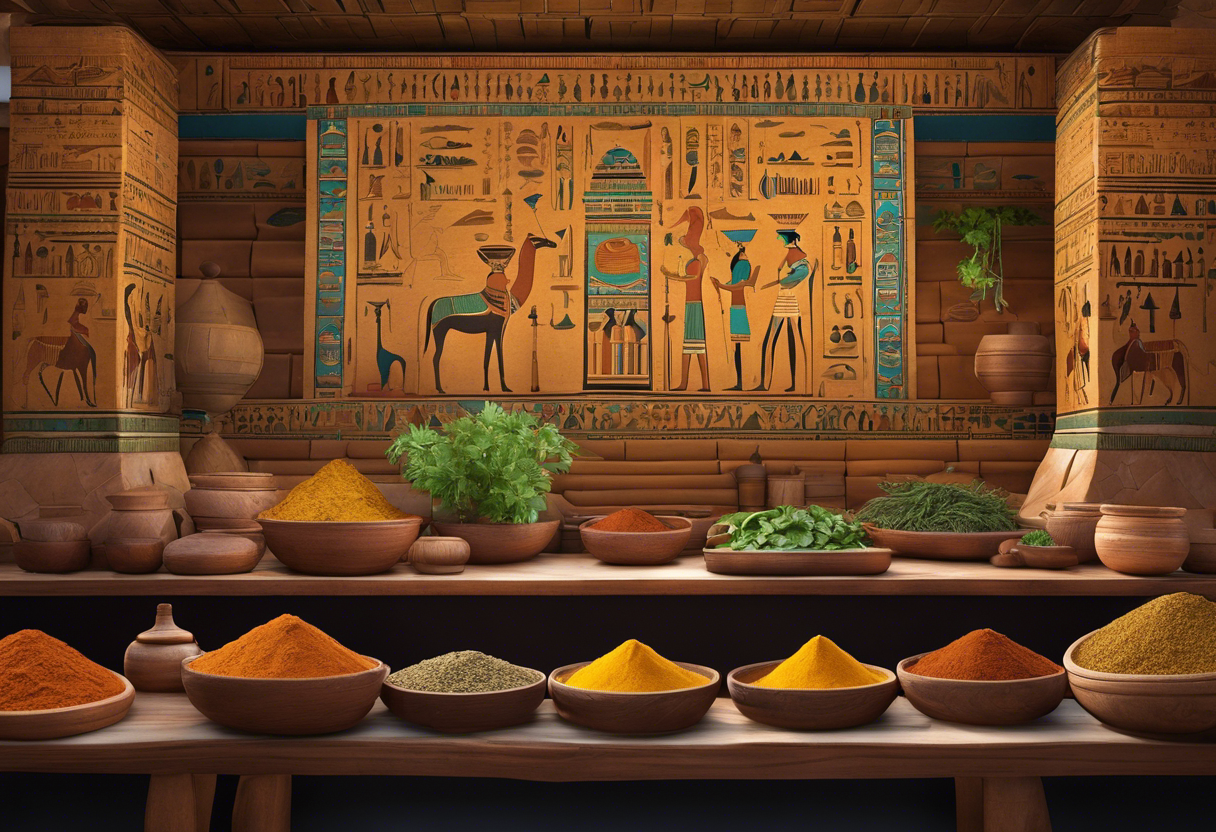
Spices and herbs played a significant role in Ancient Egyptian cuisine, adding depth, flavor, and medicinal properties to their dishes. These aromatic ingredients were not only used for culinary purposes but also had religious, medicinal, and even embalming applications.
Coriander: Coriander, also known as cilantro, was a common staple in Ancient Egyptian cooking. It was used both as a spice and herb due to its versatile nature. The seeds were ground into a powder and added to various dishes, while the leaves were used to garnish salads and stews. Coriander provided a fresh, citrusy flavor that complemented many Egyptian dishes.
Cumin: Cumin was another popular ingredient in Ancient Egyptian cuisine. Its warm, earthy flavor enhanced the taste of meat, vegetables, and lentils. Egyptians used cumin seeds in both whole and powdered form. It was also believed to aid digestion and prevent flatulence.
Fenugreek: Fenugreek was valued for both its flavor and medicinal properties. The seeds were used to enhance the flavor of bread, while the leaves were added to stews and soups. Fenugreek was believed to have a soothing effect on the stomach and was often used as a remedy for various ailments.
Garlic: Garlic was highly prized for its pungent flavor and its medicinal properties. Egyptians used garlic liberally in their dishes, considering it to be a powerful natural antibiotic. It was also believed to ward off evil spirits and protect against disease.
Onion: Onions were a staple in Ancient Egyptian cooking, valued not only for their taste but also for their medicinal benefits. Egyptians used onions in a variety of dishes, including stews and salads. Onions were believed to have detoxifying properties and boost the immune system.
Dill: Dill was commonly used as an herb in Ancient Egyptian cuisine and was particularly popular in fish dishes. Its refreshing flavor added a tangy note to salads and soups. Dill was also used for its medicinal properties, such as soothing digestive issues.
Mint: Mint was a favored herb in Ancient Egyptian cuisine due to its fresh, cooling flavor. Egyptians used mint leaves to garnish salads, flavor beverages, and infuse oils. They also believed mint to have digestive and soothing properties.
Thyme: Thyme was used as both a spice and herb in Ancient Egyptian cooking. Its aromatic, earthy flavor enhanced the taste of meat and vegetable dishes. Thyme was also believed to have medicinal properties and was used to treat respiratory ailments.
Ancient Egyptians recognized the importance of spices and herbs not only for enhancing the taste of their food but also for their therapeutic properties. These culinary and medicinal traditions have been passed down through the ages, giving us insights into the rich flavors of Ancient Egyptian cuisine.
Mealtimes and Eating Habits in Ancient Egypt
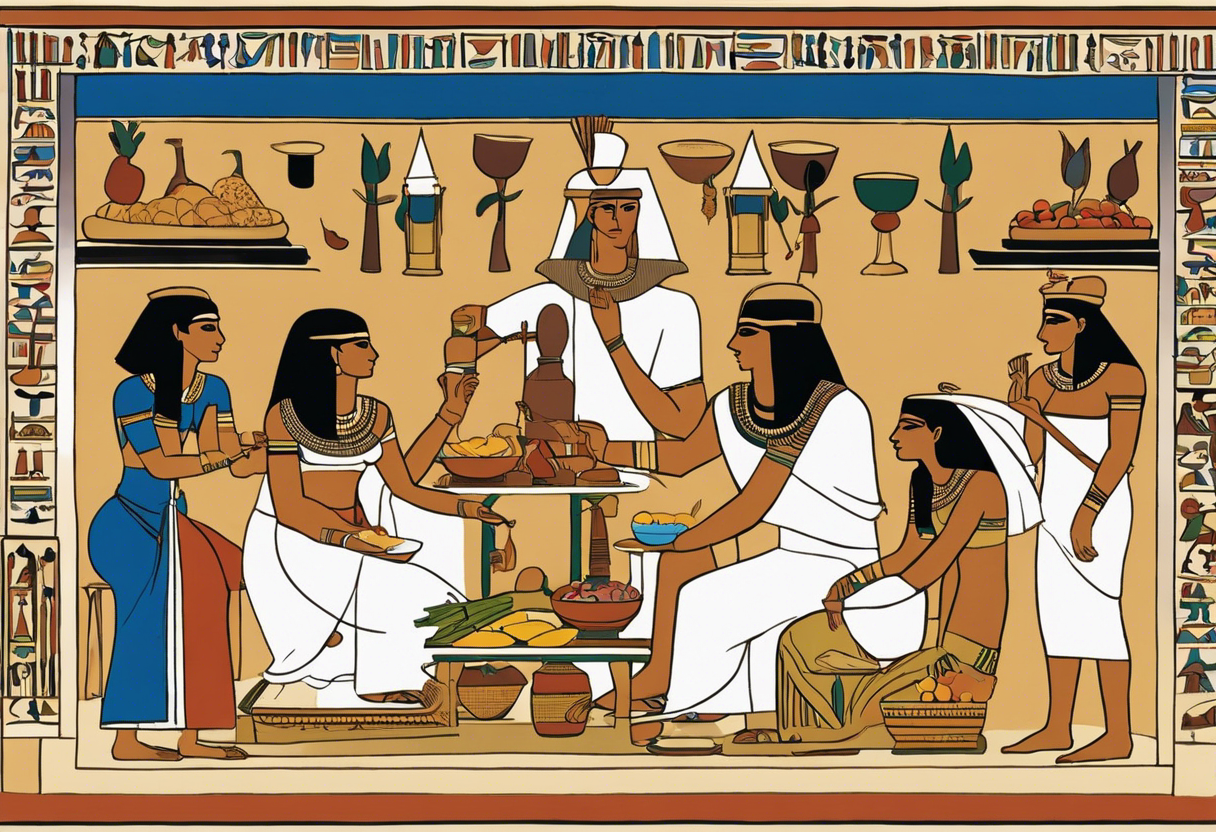
In ancient Egypt, mealtimes and eating habits were integral parts of daily life and reflected the cultural and social practices of the time. The Egyptians placed great importance on their meals, viewing them as not only a means of sustenance but also as a way to connect with family and friends.
Daily Meals
The ancient Egyptians typically had three main meals throughout the day: breakfast, lunch, and dinner. However, the exact timing and composition of these meals varied depending on a person's social status and occupation. Wealthy Egyptians often had more elaborate and diverse meals, while peasants had simpler fare.
Breakfast
Breakfast, or "Itnu," was considered the most important meal of the day in ancient Egypt. It was typically a light meal consisting of bread, beer, and occasionally fruits such as dates or figs. Bread was a staple food in ancient Egypt and was made from a mixture of wheat or barley flour and water. Sometimes, butter, honey, or cheese was also added to enhance the flavor.
Lunch
Lunch, known as "Akheta," was the main meal of the day and consisted of a more substantial spread. Egyptians enjoyed a variety of dishes during lunch, including vegetables like onions, beans, garlic, and lettuce. They also consumed meat, primarily in the form of fish, poultry, and occasionally pork. These meats were either grilled, boiled, or roasted. Bread continued to play a prominent role and served as a common accompaniment to the meal.
Dinner
Dinner, or "Hut," was a lighter meal compared to lunch and was usually enjoyed later in the evening. It typically consisted of leftovers from lunch or simpler dishes. Ancient Egyptians would have eaten the remaining bread, vegetables, and perhaps some fruits. Dairy products like cheese and yogurt were also sometimes consumed during dinner.
Eating Habits
The ancient Egyptians had specific customs and rituals related to eating. It was common for people to sit on the floor or on low stools around a communal table while sharing their meals. They used their hands to eat, although spoons and knives made from materials like wood or ivory were also used by the more affluent members of society.
Ancient Egyptians believed that good hygiene was important, so they washed their hands before meals, and sometimes even their feet. It was also customary to offer a prayer or blessing before eating, acknowledging the gods and expressing gratitude for the meal.
Conclusion
The mealtimes and eating habits in ancient Egypt showcased the significance of food in their culture and society. The three main daily meals, along with the inclusion of staple foods like bread, highlighted the importance of sustenance and nourishment. Additionally, the customs and rituals surrounding mealtimes underscored the Egyptians' appreciation for communal dining and their respect for the divine. These ancient eating habits provide valuable insights into the daily lives and traditions of the people of ancient Egypt.
The Significance of Food in Ancient Egyptian Culture and Religion
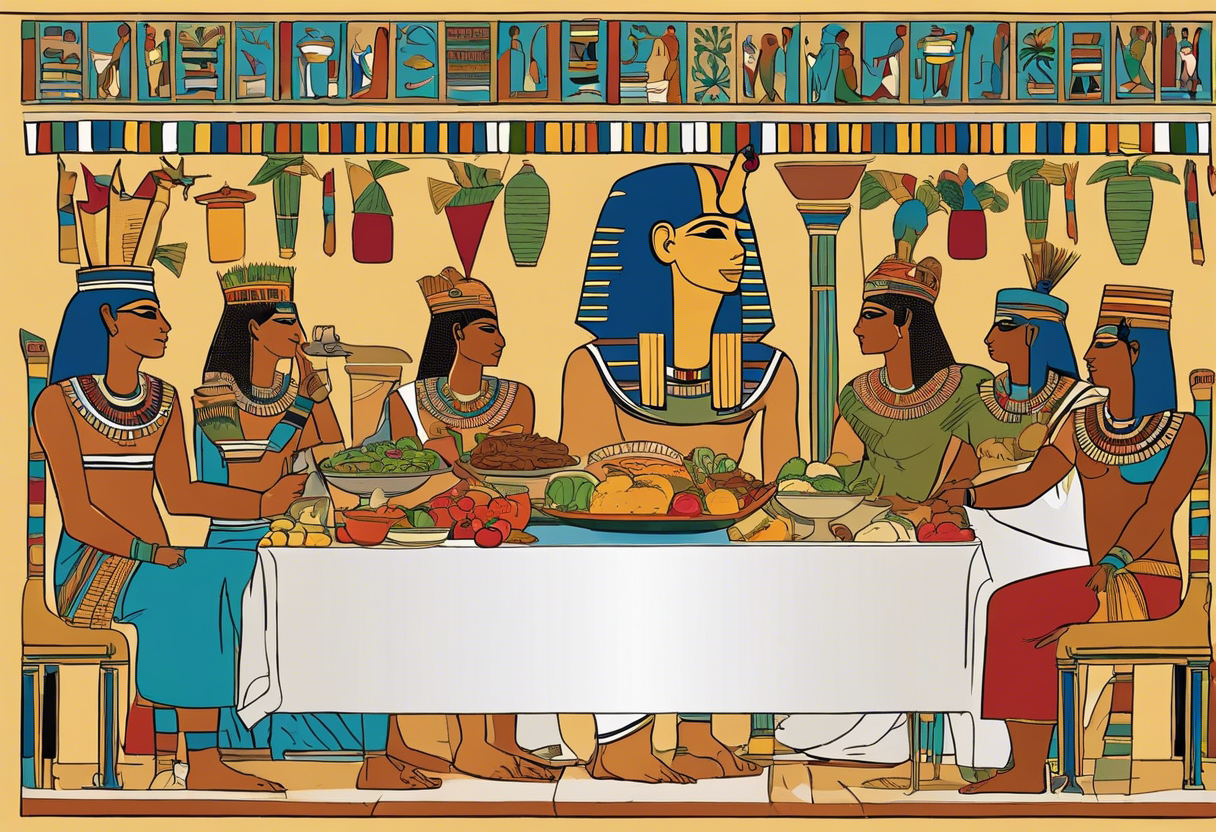
Food held great significance in the ancient Egyptian culture and played a crucial role in their religious practices. The Egyptians believed that food was not only necessary for sustenance but also had spiritual and symbolic importance.
Offerings to the Gods: One of the most significant ways in which food played a role in ancient Egyptian religion was through offerings to the gods. The Egyptians believed that by offering food to the gods, they could establish a connection and receive their blessings in return. Temples were adorned with elaborate rituals where priests offered a wide variety of foods, including bread, fruits, vegetables, meat, and wine, to the statues of gods and goddesses.
"Offering food to the gods was a way to show respect and gratitude, as well as to seek divine protection and favor."
The Journey to the Afterlife: Food held a vital role in the belief system surrounding the afterlife in ancient Egypt. The deceased were provided with a variety of food items, known as "funerary offerings," to sustain them in the afterlife. These offerings were often depicted in tomb paintings and included items such as bread, beer, wine, meats, fruits, and vegetables. It was believed that the deceased would consume these offerings, ensuring their well-being in the afterlife.
Dietary Restrictions and Symbolism: The Egyptian society had specific dietary restrictions based on cultural and religious beliefs. For example, the consumption of pork was forbidden, possibly due to the association of pigs with Seth, the god of chaos. The Nile fish, on the other hand, was considered pure and was a common food source. Additionally, certain foods, such as onions and garlic, were associated with impurity and were avoided by priests and individuals practicing strict religious rituals.
Symbolism in Food: Food also held symbolic meaning in ancient Egyptian culture. Bread, for instance, was considered a staple food and symbolized life and sustenance. The Egyptians valued bread so highly that it often accompanied them in their tombs. Similarly, certain fruits and vegetables, such as figs and lettuce, were associated with fertility and were often offered in religious rituals. The symbolism attached to different foods reflected the deep-rooted beliefs and values of the ancient Egyptians.
"The symbolism of food in ancient Egyptian culture provides insights into their beliefs about life, death, and the divine."
The significance of food in ancient Egyptian culture and religion cannot be overstated. It played a vital role in religious rituals, served as offerings to the gods, aided in the journey to the afterlife, and carried symbolic meaning. Understanding the importance of food in the lives of the ancient Egyptians provides valuable insights into their cultural practices and beliefs.
Innovative Cooking Techniques and Kitchen Tools of Ancient Egypt
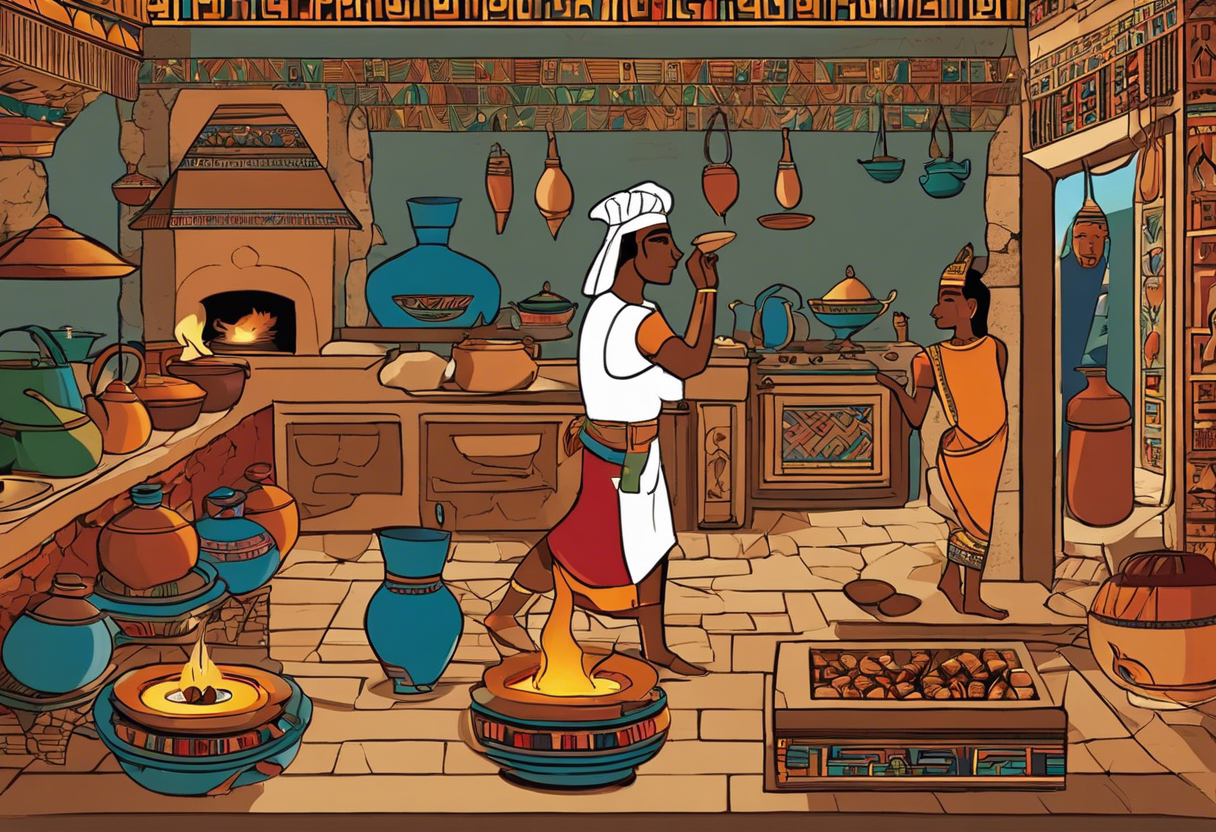
Ancient Egyptians were remarkably resourceful when it came to their cooking techniques and the tools they used in their kitchens. Their culinary practices were an essential part of their daily life and culture. This section will explore some of the innovative cooking techniques and kitchen tools that were prevalent in ancient Egypt.
Clay Ovens and Open Fire
Cooking in ancient Egypt was primarily done using clay ovens and open fires. These clay ovens, known as "tannour," were dome-shaped and made from mud or clay. They were built partially underground, with a small opening at the top to allow for the insertion of food. The ovens were heated by placing burning wood or charcoal inside, creating an even heat distribution.
Open fires were also commonly used for cooking, especially for grilling and roasting meat. Meat, such as beef, lamb, or poultry, would be skewered and placed directly over the fire.
Copper and Bronze Cookware
Ancient Egyptians used a variety of copper and bronze cookware in their kitchens. These metals were highly valued and had excellent heat conductivity, making them ideal for cooking. Cookware, such as pots, pans, and cauldrons, were typically made from these materials.
Copper and bronze vessels were often decorated with intricate engravings or carvings, showcasing the craftsmanship of the ancient Egyptians. These vessels were used for boiling water, cooking stews, and preparing various dishes.
Grinding and Milling Tools
Grain played a significant role in the ancient Egyptian diet, and therefore, grinding and milling tools were essential in every kitchen. One of the primary tools used was the "quern," a grinding stone composed of two circular stones. Grain would be placed between the stones, and by rotating the upper stone, the grain would be crushed into flour.
Apart from the quern, the ancient Egyptians also used hand mills and pestle and mortar for grinding spices and herbs. These tools allowed them to create flavorsome blends for their dishes.
Earthenware and Alabaster Utensils
In addition to cookware, ancient Egyptians also used various utensils made from earthenware or alabaster. These materials were readily available and provided a practical alternative to more expensive copper and bronze utensils.
Earthenware bowls, plates, and cups were used for serving food and beverages. Alabaster jars and containers were commonly used for storing liquids, such as oil or wine.
Bread Moulds and Baking Techniques
Bread was a staple food in ancient Egypt, and the Egyptians had developed innovative baking techniques and tools to make it. Bread dough would be shaped into various forms using wooden or clay moulds, giving it different shapes and patterns.
Baking was typically done in clay ovens, and the bread would be placed directly on the oven floor or on heated clay plates. This ensured that the bread was evenly baked and maintained its shape.
The ancient Egyptians' innovative cooking techniques and use of kitchen tools not only allowed them to create delicious and diverse dishes but also showcased their ingenuity and resourcefulness. These culinary practices have undoubtedly left a lasting impact on the development of cooking techniques throughout history.
The Influence of Ancient Egyptian Food on Modern Cuisine
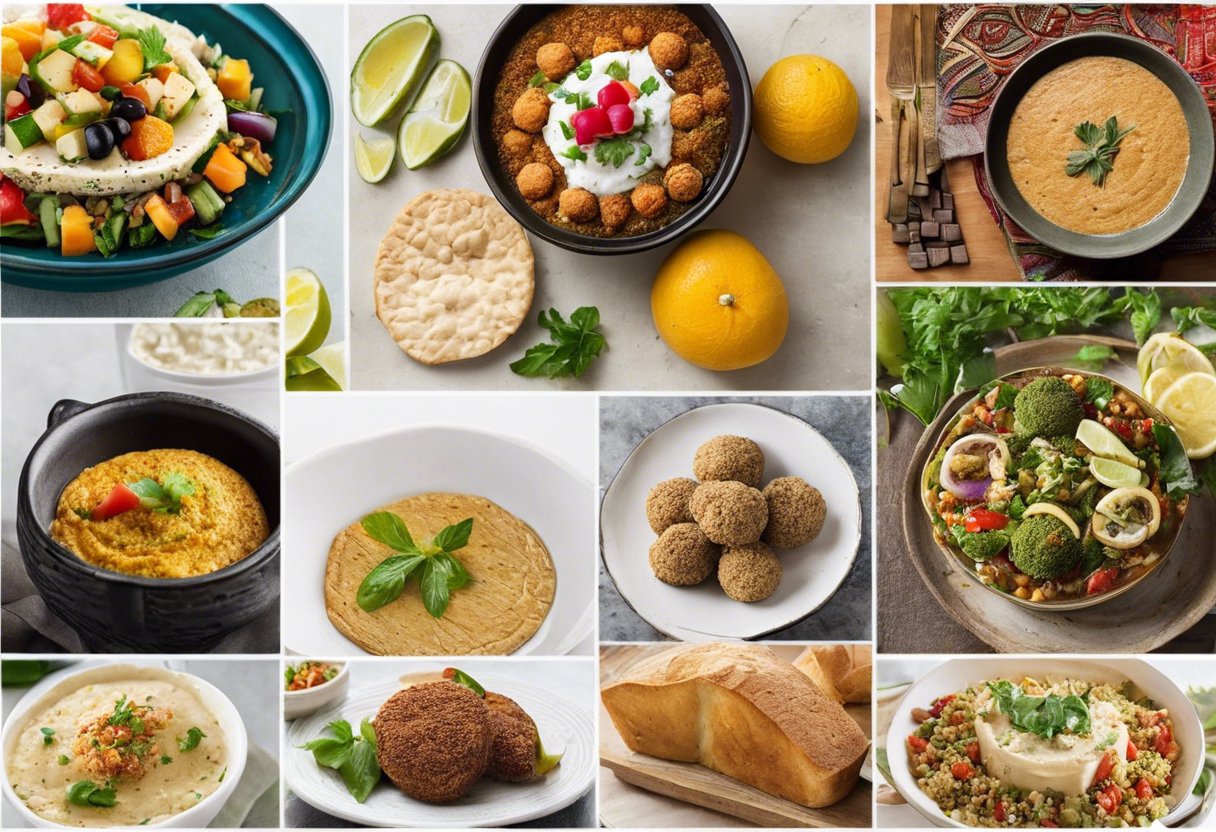
The culinary traditions of ancient Egypt continue to play a significant role in shaping modern cuisine. With a rich history spanning thousands of years, ancient Egyptian food has left a lasting impact on the culinary world. From staple ingredients to cooking techniques, the influence of ancient Egypt can be seen in various dishes enjoyed today.
Staple Ingredients
Ancient Egyptians relied heavily on certain staple ingredients that are still prominent in modern cuisine. One such ingredient is bread, which was a dietary staple for both ancient Egyptians and many cultures today. Ancient Egyptians used hieroglyphs to depict various types of bread, highlighting its importance in their diet.
Another staple ingredient was grains, particularly barley and wheat. The ancient Egyptians were skilled agriculturalists and their grain-based diet was a result of their agricultural success. Even today, grains like rice, wheat, and barley play a fundamental role in many cuisines.
Flavorful Spices and Herbs
The ancient Egyptians were known for their use of flavorful spices and herbs to enhance the taste of their dishes. They used spices like coriander, cumin, and mustard extensively, which are still commonly used in various cuisines worldwide. The use of herbs such as dill, parsley, and mint was also prevalent in ancient Egyptian cuisine.
Culinary Techniques
Ancient Egyptians developed advanced cooking techniques that have influenced modern culinary practices. They were skilled in methods such as roasting, baking, and boiling. Additionally, they perfected the art of fermentation to preserve various food items. These techniques continue to be utilized in modern cooking methods, showcasing the enduring impact of ancient Egyptian practices.
Iconic Dishes
Certain iconic dishes from ancient Egypt have survived through the centuries and are enjoyed by people today. One example is ful medames, a popular Egyptian dish made from simmered fava beans. This dish is still widely consumed in Egypt and has gained popularity in other parts of the world.
Another notable dish is koshari, which is a hearty and flavorful combination of rice, lentils, and pasta, topped with a spiced tomato sauce and crispy caramelized onions. Koshari has become a beloved street food in Egypt and is recognized for its unique blend of flavors.
Global Influence
The influence of ancient Egyptian cuisine extends beyond the borders of Egypt. Throughout history, Egyptian traders and travelers spread their culinary traditions to various regions, leaving a mark on the cuisines of neighboring cultures. The widespread popularity of dishes like hummus and falafel can be traced back to the influence of ancient Egyptian food.
In conclusion, ancient Egyptian food continues to shape modern cuisine through staple ingredients, flavorful spices, culinary techniques, iconic dishes, and its global influence. As we delve into the culinary past of ancient Egypt, we discover a rich tapestry of flavors and traditions that have helped shape the diverse world of food we enjoy today.
Notable Ancient Egyptian Recipes and Dishes
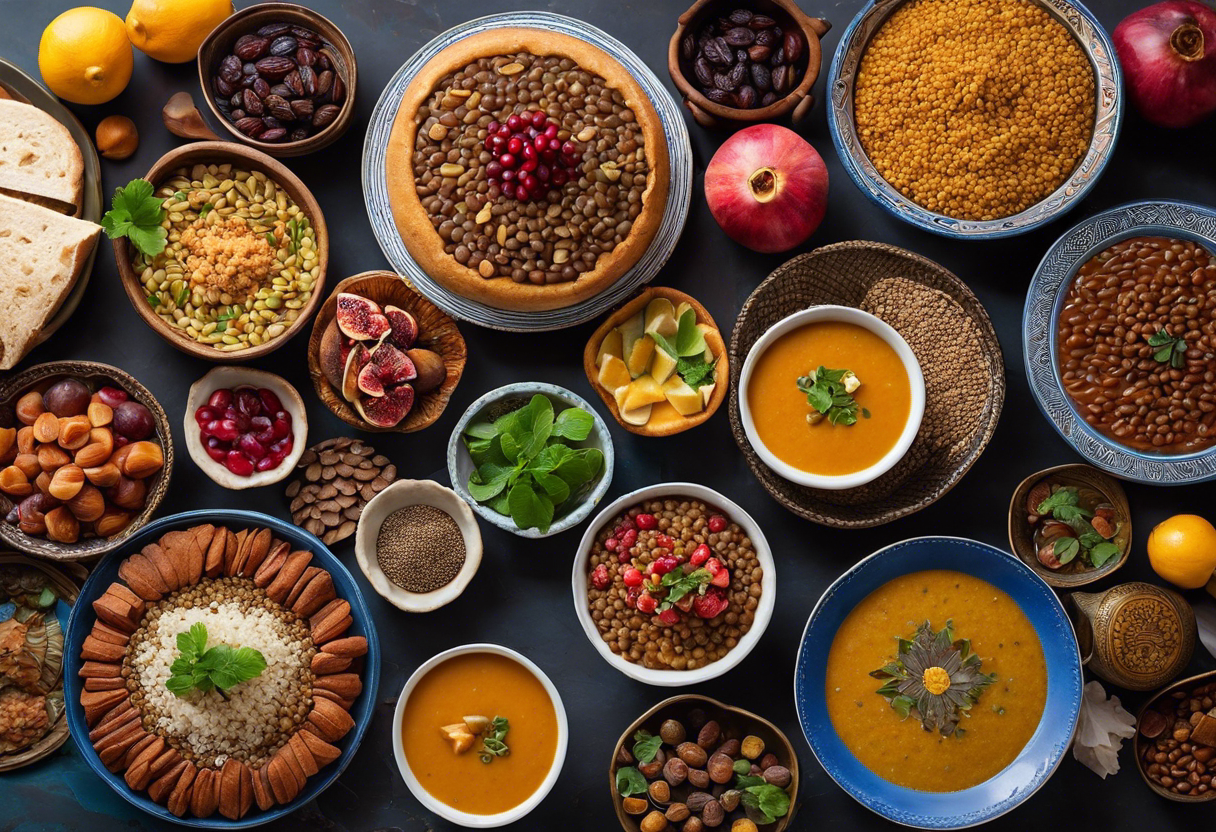
Ancient Egyptian cuisine holds a fascinating array of recipes and dishes that provide a glimpse into the culinary traditions of this ancient civilization. Passed down through generations, these recipes were often simple yet flavorful, making use of the abundance of ingredients available in the Nile River Valley. Here are some notable ancient Egyptian recipes and dishes:
1. Bread (Aish Baladi)
Bread was a staple in ancient Egyptian cuisine, and the most common type of bread consumed was Aish Baladi. This traditional Egyptian bread is made from a mixture of whole wheat flour, water, and yeast. It has a dense texture with a slightly sour taste, and it was a vital source of sustenance for the Egyptian people.
2. Ta'amia (Egyptian Falafel)
Ta'amia, also known as Egyptian falafel, is a popular street food in Egypt with roots in ancient Egyptian cuisine. It is made from ground fava beans mixed with herbs and spices such as coriander, cumin, and garlic. The mixture is then shaped into small patties and deep-fried until golden brown. Ta'amia is often served with tahini sauce or stuffed into pita bread with various toppings.
3. Mulukhiyah
Mulukhiyah is a nutritious dish that originated in ancient Egypt and is still widely consumed today. It is made from the leaves of the mulukhiyah plant, which are cooked down to create a thick, green stew-like consistency. Often prepared with chicken or meat, mulukhiyah is flavored with garlic, coriander, and other aromatic spices. It is typically served over rice and enjoyed for its rich taste and health benefits.
4. Bastilla (Pastilla)
Bastilla, also known as pastilla, is a savory pie that dates back to ancient Egyptian times. It is typically filled with layers of seasoned meat, such as chicken or pigeon, along with a mixture of eggs and almonds. The filling is encased in layers of thin pastry and baked until golden and crisp. Bastilla is usually dusted with powdered sugar and cinnamon, giving it a delightful combination of sweet and savory flavors.
5. Honey-Sweetened Beverages
Honey was widely used as a sweetener in ancient Egypt, and it played a crucial role in beverage preparations. One such popular beverage was mead, a fermented drink made from honey and water. Another notable drink was carob juice, made from crushed carob pods mixed with water and sweetened with honey. These honey-sweetened beverages were enjoyed for their refreshing taste and energizing properties.
6. Lentil Soup
Lentils were a staple in ancient Egyptian cuisine, and lentil soup was a common dish consumed by the Egyptian people. The recipe for lentil soup typically involved simmering lentils in a flavorful broth seasoned with onions, garlic, and spices such as cumin and coriander. The result was a hearty and nourishing soup that provided sustenance to the population.
These are just a few examples of the diverse range of recipes and dishes that were part of ancient Egyptian cuisine. The culinary traditions of this ancient civilization continue to intrigue and inspire people today, offering a connection to the rich history and culture of Egypt.
Exploring Ancient Egyptian Beverages

The ancient Egyptians were known for their appreciation of good food and drink. From beer to wine to various herbal concoctions, beverages played an important role in their culture, rituals, and daily lives.
One of the most popular alcoholic beverages in ancient Egypt was beer. It was a staple in the Egyptian diet and was consumed by people of all social classes. Beer was brewed using barley, which was soaked in water, mashed, and left to ferment. The fermentation process was enhanced by adding dates or honey, which added a sweet flavor to the beer. Egyptians would often consume beer through reed straws directly from large communal jars.
Wine was also enjoyed by the ancient Egyptians, although it was considered a luxury and mostly consumed by the upper classes. The Egyptians produced red, white, and rosé wines, with red wine being the most popular. Grapes were cultivated and harvested, and the juice was extracted and allowed to ferment in clay jars. Wine was often mixed with water to reduce the alcohol content and make it more suitable for consumption.
Apart from these alcoholic beverages, the ancient Egyptians also enjoyed a range of non-alcoholic drinks. One such beverage was a fruit juice made from pomegranates, dates, or figs. These fruits were crushed, and the juice was extracted and mixed with water. This juice provided a refreshing and sweet alternative to alcoholic beverages.
Herbal teas were another favored drink in ancient Egypt. These teas were made from a variety of herbs and plants, such as mint, chamomile, and hibiscus. Egyptians believed in the medicinal properties of these herbs and often used them as remedies for various ailments. The teas were prepared by infusing the herbs in hot water, creating a flavorsome and aromatic beverage.
The ancient Egyptians also experimented with different flavors and ingredients in their drinks. They added spices, such as cinnamon and coriander, to enhance the taste and aroma. They also used sweeteners like honey and syrups made from fruits to add a touch of sweetness to their beverages.
Overall, exploring the ancient Egyptian beverages allows us to get a glimpse into their culture, traditions, and the importance they placed on the enjoyment of good drinks. Whether it was beer, wine, fruit juice, or herbal tea, beverages played a significant role in their daily lives and were an integral part of their social gatherings and religious ceremonies.
The Legacy of Ancient Egyptian Food in Today's World
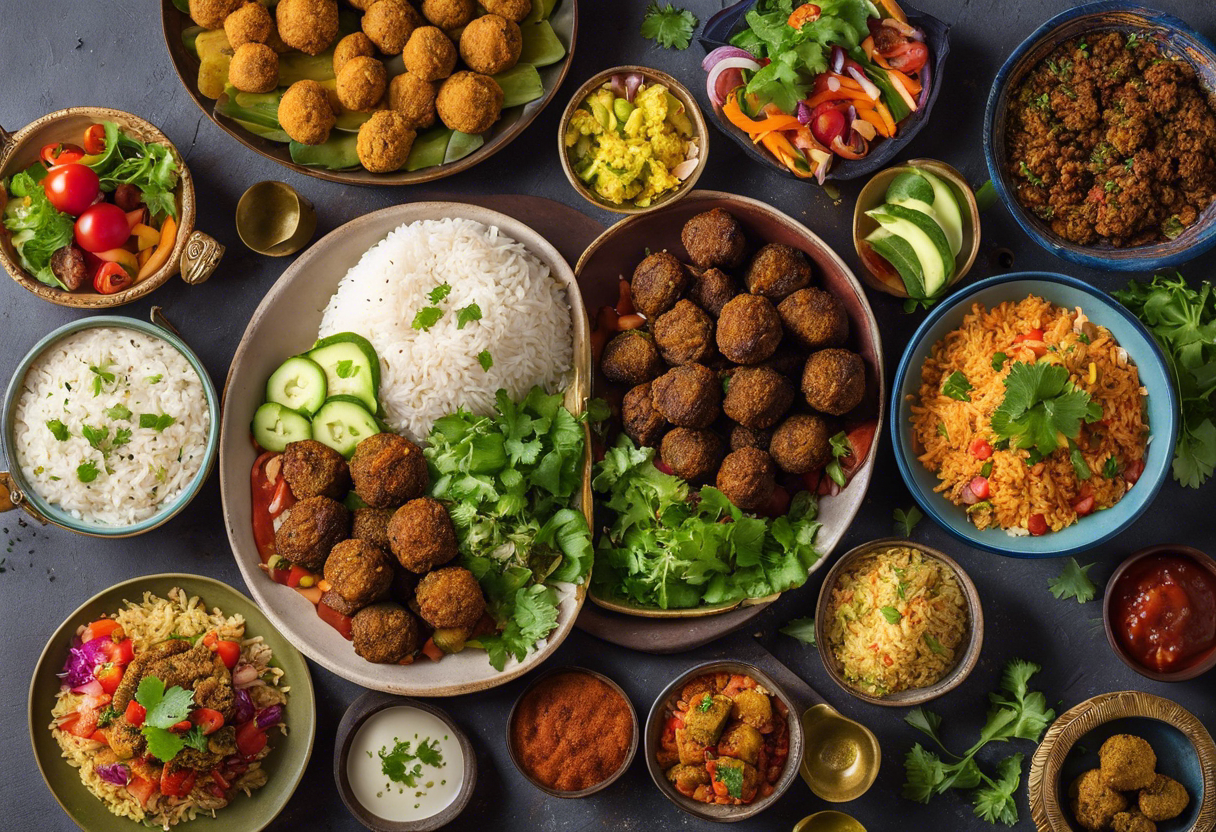
The culinary traditions of ancient Egypt have left a lasting impact on the culinary world, with several dishes and ingredients still prevalent in today's cuisine. The legacy of ancient Egyptian food can be seen in various aspects, ranging from cooking techniques to ingredients and flavor profiles.
1. Ancient Egyptian Ingredients
Ancient Egyptians had a rich variety of ingredients at their disposal, many of which are still widely used today. One such ingredient is the versatile grain known as barley, which was a staple in the ancient Egyptian diet. Barley continues to be consumed in modern times, both as a whole grain and as an ingredient in various forms such as flour and malt for brewing.
Another significant ingredient that originated from ancient Egypt is the lentil. Lentils were consumed in different forms, and their high protein content made them a valuable addition to the diet. Today, lentils are celebrated for their nutritional benefits and are popular in various cuisines worldwide.
2. Traditional Recipes
Several ancient Egyptian recipes have managed to survive the test of time and are still enjoyed today. One such iconic dish is a staple known as "koushari." This hearty vegetarian dish consists of a mixture of rice, lentils, macaroni, and chickpeas, all topped with a tangy tomato sauce and crispy fried onions. Koushari showcases the ancient Egyptians' love for combining various grains and legumes to create a balanced and flavorful meal.
3. Culinary Techniques
The ancient Egyptians were pioneers in many culinary techniques that have endured throughout history. For instance, they were among the first civilizations to develop methods for leavening bread, using natural yeasts and sourdough starters. This technique is still used today in artisanal breadmaking.
Another notable culinary technique attributed to the ancient Egyptians is fermentation. They fermented a wide range of foods, including beer, wine, and dairy products. Fermentation not only contributed to the preservation of food but also enhanced its flavors and nutritional value. Today, fermented foods like yogurt, sauerkraut, and kimchi continue to be enjoyed for their unique taste and health benefits.
4. Symbolism and Rituals
Food held great symbolic significance in ancient Egyptian culture, often playing a central role in religious rituals and ceremonies. The offering of food to the gods was a common practice, with specific foods and ingredients associated with particular deities. For example, bread and beer were considered sacred and were offered as offerings to the gods.
These symbolic associations between food and spirituality have endured in Egyptian culture. Today, during special occasions and religious holidays, traditional dishes and sweets that were once offered to the gods are still prepared and shared among families and communities.
The legacy of ancient Egyptian cuisine is still evident in today's world through the use of ingredients, traditional recipes, culinary techniques, and symbolic associations. By rediscovering and embracing these ancient culinary traditions, we continue to pay homage to the rich history and cultural heritage of Egypt.
